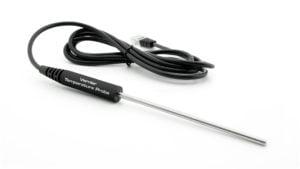The University of North Carolina at Pembroke serves a diverse student body that come to college with a wide variety of backgrounds, experiences, and motivations. Many of the school’s students are the first in their families to go to college. When the North Carolina legislature voted to help students in underserved communities by decreasing tuition costs, the college’s enrollment jumped significantly. Chemistry professor Roland Stout, Ph.D., knew that he had to engage all students in his freshman chemistry class in order to prepare them for conducting more difficult chemistry experiments later in the year.
“I needed to find a relevant yet simple way for my freshman students to connect with chemistry,” said Stout. “It meant coming up with something that would capture their interest while teaching them lab skills and how to use the Vernier technology that we have available. A real-world scenario did the trick.”
“I needed to find a relevant yet simple way for my freshman students to connect with chemistry. It meant coming up with something that would capture their interest while teaching them lab skills and how to use the Vernier technology that we have available. A real-world scenario did the trick.”
Making Chemistry Fun
For many years, Stout was using the Vernier lab book Investigating Chemistry through Inquiry to teach general chemistry. To further engage students in chemistry, he modified the “An Investigation of Urea-Containing Cold Packs” experiment to bring a real-world scenario to this lesson.
This is a really powerful way of looking at data.
Stout started this lesson by posing a hypothetical, yet realistic, problem for his students to solve. In the lesson, his students were product developers at a sports company and were tasked with developing a new line of sports cold packs. He provided prices for the different chemicals students could choose from, such as urea, several nitrates, sodium chloride, and potassium chloride, and Safety Data Sheets to understand the risks of using certain chemicals to create their cold packs. After students determined which chemicals they wanted to use, they tested their reactions and collected real-time data using the Vernier Stainless Steel Temperature Probe and the LabQuest 2 that interfaced with a computer running Logger Pro software. Students overlayed the data all together to create a visual indicator of the chemistry taking place. This made the differences between their materials stand out. “This is a really powerful way of looking at data,” said Stout.
After students determined which materials they were going to choose, they created a presentation to pitch their choice to the company president, or in this case the rest of the class. “By having students defend their choice, they found that hazards and costs are a key component of product development,” Stout explained. For example, while nitrates produced a chemical reaction that resulted in the most dramatic lowering of temperature, there are some hazards related to their use. “While urea is the safest and cheapest, it does not produce the same amount of temperature decrease.”
Getting to Success
According to Stout, students were engaged in the assignment and got excited about their research. There was more discussion in the lab than in years past, and the lab reports demonstrated a higher level of student understanding by putting the lab into perspective vs. reiterating what they had done. When given the opportunity to apply chemistry principles to practical scenarios outside the laboratory, students gain a deeper understanding of what they’ve learned.
Stout has used a similar format in other labs, and his class is so popular now that it is talked about and sought after by students. “I am satisfied that this lab is doing for students what I want it to do and is helping build laboratory skills, in addition to helping them understand chemistry. They are getting experience collecting and making sense of data, which is something they will need to do as they start creating their own experiments later in the course. By taking this real-world approach, students are learning more and retain the information longer.”
By taking this real-world approach, students are learning more and retain the information longer.
Our technology has helped educators find innovative ways to teach science for over 38 years. This experiment could be replicated easily with Go Direct® Temperature Probe. Find out more about our College Chemistry resources.
About the Educator
Roland Stout holds a Ph.D. in chemical physics and teaches introductory, environmental, analytical, and physical chemistry courses from the freshman to graduate level. One guiding passion in all of these classes is the desire to connect chemistry to everyday experiences so that students better understand chemistry’s importance.



